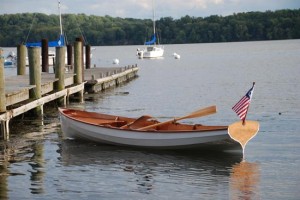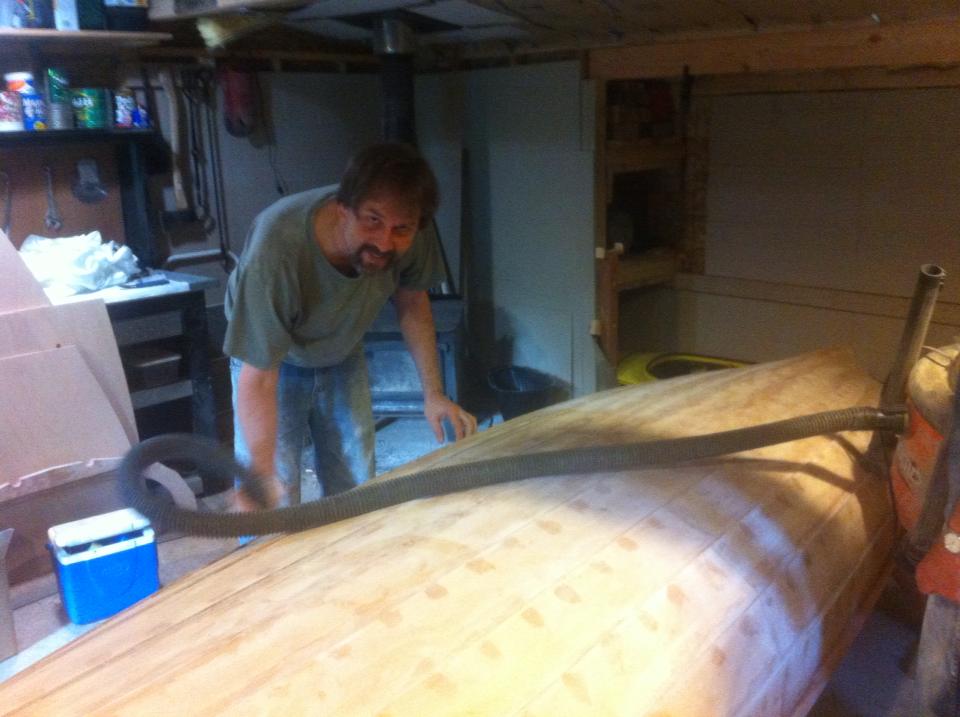In the hierarchy of things that constitute “simply messing about in boats” sailing is at the head of the list. Next is time spent building, restoring, painting or in any way physically advancing a boat from land-bound to seaborne. Time spent in the boatyard or the shop has a quality that transcends common hours. The effect is enhanced when such activities include equal parts cold beer and friends.
AÂ friend of mine who used to work for the same employer as me is building a boat in a shop he built. It’s very different from the wide open spaces of an industrial park setting but it has a style and a spare utility that makes a fellow feel at home. Dave Eckler is a graduate of the Wooden Boat School in Port Hadlock, Washington. He is an east coast transplant like myself. Knowing that I am a sucker for a pretty hull form and a dab hand at pretending to be competent at all things maritime he requested my assistance at various stages of his building project. Joining us was Caleb Stott, another coworker, who drifted into the local super yacht industry with a fine woodworking skill set and a discerning palate for today’s micro-brews. The beers that cemented our working relationship were a stalwart Alaskan Amber and the cased assortment from the New Belgium Brewing Company.

The finished Chester Yawl will look like this little beauty. (photo by permission of Chesapeake Light Craft, LLC.)
The boat that brought us together is a kit from Chesapeake Light Craft, their Chester Yawl row boat design. It is an adaptation of the classic whitehall design translated into modern marine grade plywood. The old school cedar planks and copper rivets are replaced with a construction method called lapstitch. This consists of planks which join each other along overlapping edges. The bottom edge of each okoume plywood plank has a rabbet which provides alignment, and once epoxied together, a great deal of strength. Planks are assembled and held together by copper wires that pass through adjoining holes in the plank edges. The wire ends are twisted together to draw everything together tightly. At the end of all this one has an upside down hull presenting approximately 180 linear feet of bare seam which must be cemented together into a unified structure. One of the most time consuming parts of the project is running beads of thickened epoxy along each plank lap to bond them all together. Our team provided the needed solidity by applying God’s gift to inorganic chemistry with a bit of filler to make it, as they say in tech journals, less runny and more gloppy.
Epoxy loves a bit of heat to cure and come to the proper hardness. Port Angeles has a moderate climate and Dave’s home and shop are in a wooded area that assured lower temperatures than would be best for curing epoxy. The wood stove had been going long before I arrived. This brought the shop up to 80 degrees for the duration of the job. A cooler just outside the shop door provided the cold comfort needed to bring everyone back to efficient operating temperature.
Having the boat on a low stand gave easy access to the ten rows of seams each of which needed to be filled and filleted. We Donned nitrile rubber gloves and mixed small batches of MAS epoxy in plastic cups. MAS makes the metering of the material easy as their pumps dispense the epoxy in doses such that an equal number of pumps for both resin and hardener will give the proper mix. We added enough silica filler to bring the batch to a mayonnaise sort of consistency. The epoxy mix was then scraped, shoveled, oozed and generally coerced into a plastic zip lock bag with a corner cut off. Thus armed one feels less like a boat builder and more like a cake decorator.
Applying the glue requires a steady hand and some basic restraint. It would be easy to make a real mess of the job. We took our time and did our best to make a careful job of it. One needs to remember that excess epoxy not removed at this stage will need to be sanded off later. That way lies madness and carpal tunnel syndrome. We kept rags and denatured alcohol handy for cleanup. It’s best to skip applying glue where the thousand and one twisted wires cross the plank laps. We did not follow this rule very well and that gave Dave a little more work to do later. Working alone this job would have occupied six or eight hours of an unpracticed workers time. We did it in about two hours.
There is satisfaction in a job well done. It is equaled by a mixture of conversation and common labor that traces the connections between diverse individuals who appreciate honest opinions leavened by large doses of good humor. It surely made the effort worthwhile and lent it’s own measure of quality to the project. As important as the joining of wooden parts is the meeting of minds and the bonding of our better natures.


